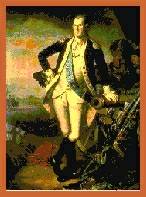|
PinkMonkey Online Study Guide-World History
6.3 Course of the American Revolution
King George III sent armies to put down the colonies without having a proper idea of their strength. In the early stages of the war, the armies of the colonies suffered reverses because they were not well trained and did not have the adequate equipment.
However, under their great leader George Washington, fortune favored the colonists when the British army surrendered to the Americans at Saratoga in 1777. Spain, France and Holland supported the American armies. In October 1777, France openly promised aid and in 1778 it made an alliance with the US. France had been deprived of Canada and her possessions in India. She looked forward to recovering them by helping the colonists. Spain also wanted to recover her lost possessions in Florida, Minorca in the Mediterranean and Gibraltar. Hence in 1779, Spain united with France to help America. Holland also joined France in order to spite England as a trade rival.

Exhibit 6.2
The first US president, George Washington
England lost hope, when her command over the seas was
weakened. Thus in 1781, the British Commander in chief Lord Cornwallis,
had to surrender to Washington at Yorktown. In 1783, the Peace Treaty
was signed at Paris, in which England acknowledged the independence
of the colonies.
[next page]
|
Index
6.0 Introduction
6.1 Causes of the American Revolution
6.2 Immediate Cause
6.3 Course of the American Revolution
6.4 Reasons for American Success
6.5 Consequences of the American Revolution
6.6 Significance of the American Revolution
6.7 Dates & Events
6.8 Points to Remember
Chapter 7
|